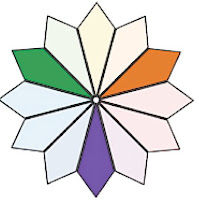Color has always been the main focus of my jewelry designs. Mixing and matching different colors can drastically effect the overall concept. From decorating your home to selecting an outfit, color should be considered.
Here's a look at the color wheel created by Johannes Itten that might have you looking at color a bit differently.
How the Color Wheel Works
Creative use of color has always been a hallmark of artists and skilled craftspeople. The Color Wheel lets you use basic color theory by quickly and easily determining each type of color relationship. Johannes Itten developed the perfect visual tool: a 12-color wheel. With his color wheel, it is fun and easy to develop color schemes that work.
The wheel starts with the three primary colors equidistant from each other: yellow, red and blue.
Mixing two primaries creates a secondary color. The three secondaries are: orange, violet and green.
Mixing a primary color with a nearby secondary color yields a tertiary color. The six tertiaries are: yellow-orange, red-orange, red-violet, blue-violet, blue-green and yellow-green.
Four Color Schemes
Monochromatic Scheme: The most simple way to create a beautiful piece is to use the same color throughout, but by using lighter and darker elements. Shown are various shades and tints of green.
Analogous Scheme: Always pleasing to the eye are colors that are close to each other on the wheel, like yellow to orange to red-orange.
Complementary Scheme: Nothing stirs excitement like the eye candy, high contrast effect of a complementary color scheme. Complementary colors are directly opposite each other on the color wheel and are always stimulating if their hues are pure. A beautiful, more subdued harmony can be achieved by using light or dark complementary pairs.
Split-Complementary Scheme: This scheme combines the effect of the powerful complementary scheme with a variation on the analogous scheme. It offers intriguing possibilities in complexity and sophistication. Determine a key color. Then go directly across the color wheel to find its complement. Instead of the complement, use the two colors that you find next to it. In this example the key color is green. Instead of green's complement (red), its split-complements were chosen: red-orange and red-violet.







No comments:
Post a Comment